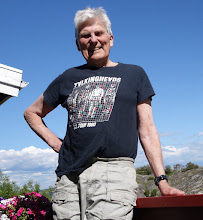The speeches by Michelle Obama and Bill Clinton led me to submit comments on both. I also submitted a comment on a seemingly unrelated article by Gina Kolata about the latest advances in genome research.
Here are the URLs. In using the second one you have to go to reader recommended and then down to about 187 recommended.
nytimes.com/2012/09/05/us/politics/michelle-obama-speaks-as-democratic-convention-begins.html?pagewanted=all#comments
In all three comments I refer to Somali women in Somalia, here in Linköping, Sweden where I live, and in Burlington, Vermont where I usually spend 4 weeks in the summer. We who write comments must hold ourselves to 1500 characters for each comment, many thoughts cannot be fully explained. This became clear when “Chavito” submitted a good reply on one of my comments in which it became clear that my “Somali women stories” could not be fully understood by reading the comments alone.
I
file this post to introduce you to the Somali diaspora here in Linköping, Sweden and to begin an explanation of the background for recommending that Michelle Obama get to know Somali women here in Sweden and in America, maybe in Burlington, Vermont. I can only begin tonight but do so in case anyone (my Somali friends) looks at my blog tonight, Swedish time.
In Rochester, New York, where I was a professor, I knew African Americans (not defined here) but I of course never knew a Somali-born person and knew nothing of Somalia. We moved to Sweden in 1996 and one day several years later, quite by chance, I found myself visiting the Red Cross Träffpunkten (Meeting place).
There I met my first Somali, and older male, named Mohammed. Soon after I met my second and I show him to you here in this picture taken September 6. His name (short version) is Abdi , and he is the Somali sitting second from the left around the table at Träffpunkten where we "Träna svenska". The woman is my Swedish colleague Gunilla. Refugees of all ages come to the Red Cross four days a week to practice Swedish with Gunilla and me and many others and/or to get help with their school homework. On this afternoon, we were simply discussing a wide range of subjects and, in the process, teaching and learning more Swedish.
CLICK ON THE PICTURE AND YOU WILL SEE ALL OF THEM AROUND THE TABLE!
Now to the Somali women, whom you will never see in pictures. Consider the Black Book on the table. That book is the newest volume of my Book of Names-Namnens bok. Every time I sit around a table with such a group I ask each person if he or she is willing to write their name in one of the books and to do so both in Latin characters and in the characters of their first language, most often Arabic or Farsi/Dari (Persian in Iran and Afghanistan).
These books document that I have met in the past year or so more than 100 Somali-born girls, young women, and older women and a great many of their male counterparts. Until I started becoming acquainted with these people the only Somalis I knew anything about were Waris Dirie and Ayan Hirsi Ali.
Now, thanks to countless conversations with the Somali-born, I have been able to learn more and more and to learn especially about questions having to do with health and giving birth. In this I have been helped especially by being able to read the many publications of two Swedish researchers, Dr. Birgitta Essén M.D. and Professor Sarah Johnsdotter (Anthropologist).
So to close this for the evening (Thursday, 6 September) I refer to the public health issue that leads me to write in my NYT comments about Somali women.
In Somalia both the risk of a mother dying during the birth process and the risk of the fetus or new-born infant dying are among the greatest in the world. For the same women giving birth in Sweden the risk is reduced to being among the lowest in the world and the basic reason is Universal health care. In America we know that infant mortality places America far down the list that is topped by Sweden, and we know that a factor in this sorry story is infant mortality among the people that American sociologists refer to as "African American". There is a large Somali diaspora in America and this means that there is a large Somali-born population giving birth in America. This is readily evident in Burlington, Vermont where there is a sizable community of Somali Bantu.
With these three groups of Somali born before me, I became interested in learning more about birthing risks for these people who belong to one or two ethnic groups (depending on how you place Somali Bantu) but who live in three different environments, Somalia, Sweden, and the USA. That led me to my recommendations concerning Michelle Obama (see the comments at the URLs above).
To be continued.


